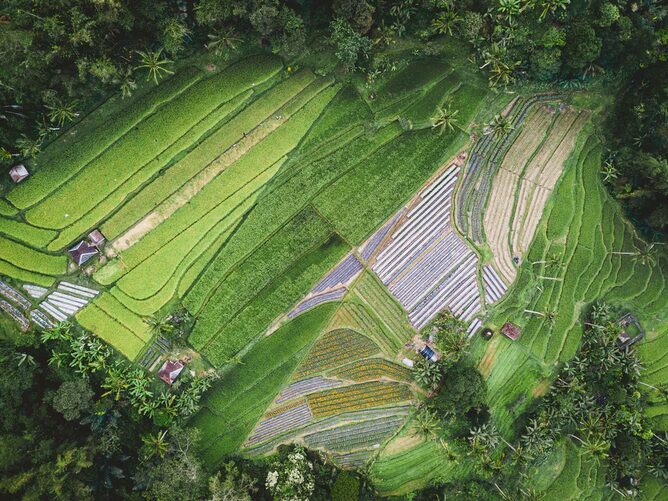How Our Current Agriculture System Harms the World (Guest Post)

For thousands of years, much of the process of growing crops was carried out in harmony and in balance with nature. Early farmers utilized the tools at their disposal, eventually developing complex systems such as the awesome Incan terraces that eventually produced more than 3000 distinct varieties of potatoes in the rainforests of South America. As humans continued to manipulate the Earth’s rich soil to feed a growing global population, agriculture became more efficient, primarily driven by monoculture. In about 1904, monoculture entered the global agricultural scene, forever changing the industry.
Along with greater efficiency, monoculture allows for higher crop yield. But the inherent benefits of monoculture come with a heavy price, as far as the natural world is concerned. For starters, successful monoculture cannot be achieved without chemical pesticides, which wreak havoc on the soil and surrounding environment. The global food system is also responsible for an exorbitant amount of carbon emissions: According to Our World in Data, food production accounts for approximately 26% of the total global GHG emissions released into the atmosphere.That number encompasses all corners of the agriculture industry, from livestock and seafood production to the growing of crops, both for livestock feed and human consumption purposes. What’s more, climate change is further complicating an already troubled agricultural industry. Now, more than ever, we must seek sustainable alternatives to monoculture in order to protect the health of the planet, as well as the future of humanity.
At the Intersection of Agriculture and Climate Change
In our modern world, it has become increasingly difficult to ignore the detrimental effects of climate change. Global temperatures are rising along with sea levels, and air pollution is rampant. One of the lesser-known repercussions of climate change is particularly relevant within the agriculture industry: Soil degradation.
The severity of the situation cannot be understated. Research indicates that a full 40% of the world’s land is being used for agricultural purposes. Further, the BBC reports that “erosion, compaction, nutrient imbalance, pollution, acidification, water logging, loss of soil biodiversity, and increasing salinity have been affecting soil across the globe, reducing its ability to support plant life and so grow crops.”
Monoculture is the primary cause of the Earth’s degraded soil quality, but climate change is helping to speed the process along. Fueled by climate change, food insecurity has become a global public health crisis of unprecedented proportions: Global food reserves are shrinking, and the cost of healthy food is climbing as a result. Marginalized populations are especially susceptible to malnutrition and food insecurity.
How Soil Health Connects to Human Health
As we cultivate a greater awareness of the public health dangers of monoculture, we also develop an understanding of the connection between soil and human health. Under monoculture, vital nutrients and minerals are stripped from the soil at a rapid pace, and often cannot be replaced. By rotating nutrient-depleting crops, such as corn, with crops that can “fix” the soil, the issue of nutrient depletion can be quickly curbed.
Until the bulk of agriculture embraces regenerative and sustainable methods, however, many people are forced to take supplements to bridge existing nutrition gaps. For instance, supplements such as Vitamin B and nicotinamide mononucleotide (NMN), an enzyme that plays an active role in your body’s metabolic processes, can provide a much-needed health boost. Yet supplements can’t completely stand in for food-based nutrients, and our immune systems may be compromised over time.
And make no mistake: In our post-COVID world, keeping your immune system healthy is a vital consideration. Weakened immune systems leave us vulnerable to all sorts of health conditions, from contagious diseases to various types of allergies. While minor health issues such as eye allergies are typically manageable with help from HEPA filters and eye drops, ensuring healthy soil that’s full of microbes virtually eliminates the need for symptom management in the first place.
Healthier Alternatives to Monoculture
Fortunately, modern technology and knowledge of regenerative agricultural practices give us myriad tools for healthier farming. For example, sustainable agriculture is gaining traction across the industry and may be helping to counteract Big Ag’s copious emissions levels. Farming methods are considered “sustainable” when expected crop yields are maintained without compromising environmental and soil health.
In lieu of monoculture, forward-thinking farmers and concerned citizens alike must advocate for healthier alternatives that improve global health rather than compromise it. Polyculture, wherein crops are rotated regularly to keep soil healthy and replenish nutrients, is one example where sustainable agriculture is concerned. Practices that are now called sustainable and regenerative have long been part of the knowledge Indigenous communities have preserved and carried forward for thousands of years. It seems as though we must look to the farmers and stewards of the past to protect public health into the foreseeable future.
Humanity as a whole can no longer afford to ignore the myriad ways in which monoculture is unsustainable and, in many ways, dangerous. Widespread environmental sustainability is virtually impossible under the monoculture farming model; thus, direct action is required from leaders within the agriculture industry. Sustainable agriculture, with polyculture and organic farming at its epicenter, is leading the change towards improved public health around the world.


